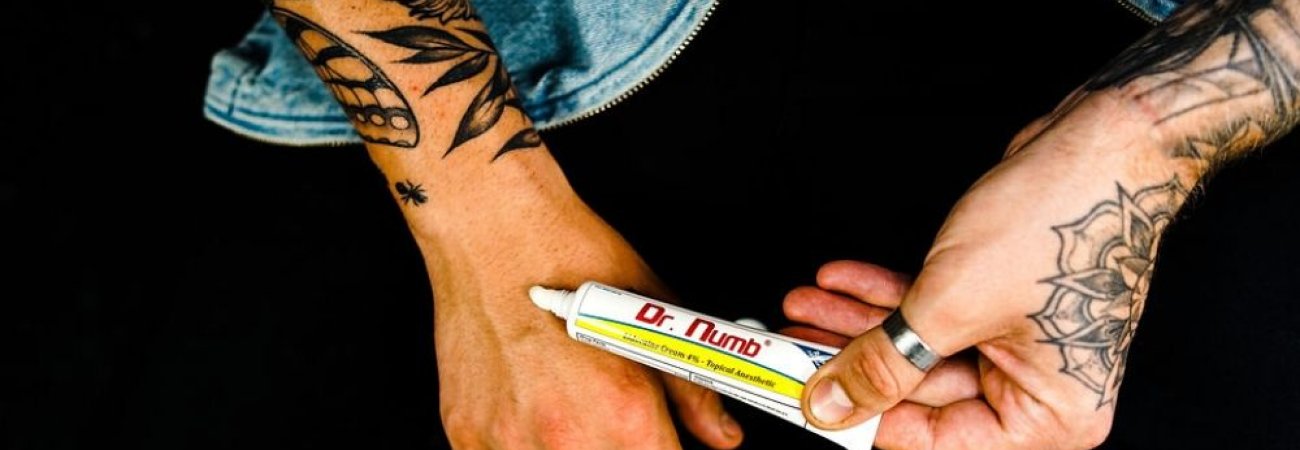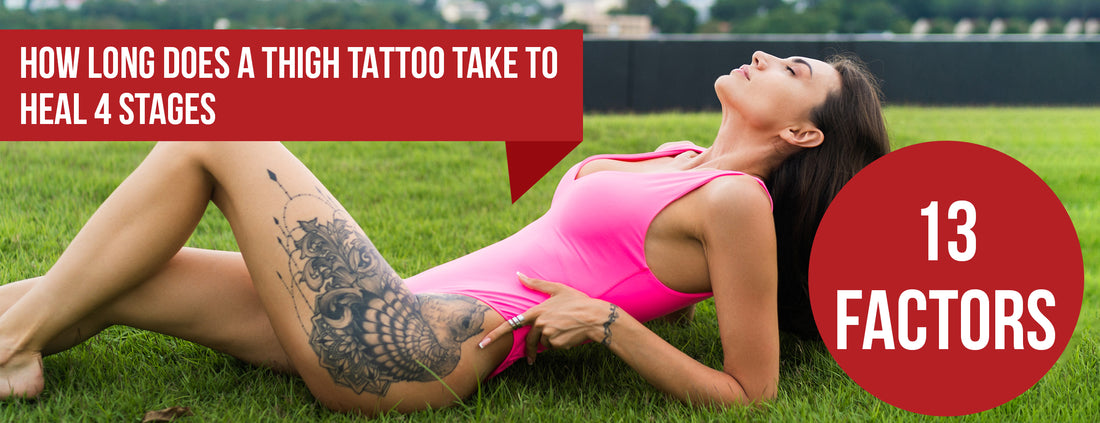Tattoo healing time varies from person to person and is determined by several factors, including size, location, and skin type.
Upper thigh tattoo recovery times vary based on individual healing rates and the tattoo's size and complexity. Healing usually takes between 1 and 3 weeks. The scabs and peeling may take up to 6 weeks to disappear completely.
In this blog post, we’ll dive into everything you need to know about healing a thigh tattoo, from the different stages of healing to the factors that can affect the overall healing time.
How Long Does a Thigh Tattoo Take to Heal: 4 Different Stages

Thigh tattoo healing is a process that can be divided into four different stages. Each stage is vital in ensuring the tattoo is healed adequately without complications or infection. You will be better prepared for what to expect during the tattoos healing process and how long it will take once you understand the stages of healing.
Stage One: Inflammation and Swelling
When you first get a tattoo, you must understand that the area will be inflamed and swollen. This is because the body is sending blood cells to the place to start the healing process. The inflammation and swelling can be quite severe, making the tattoo look raised and extra visible.
Between seven days and two weeks after getting your tattoo, any scabbing that has formed will start to harden and flake off. It’s important not to pick at or try to pull off the scabs. You may experience intense itching during this time. Typically, this stage lasts for 1-3 days, and you should expect the following:
- Swelling and redness around the tattoo.
- The tattoo is raised and looks somewhat distorted.
- Pain and discomfort around the tattoo area.
Stage Two: Scabbing and Peeling
After the initial inflammation and swelling phase, the tattoo will scab and peel. This stage's duration can last from 3 to 14 days, depending on the tattoo's size. During this stage, the body will start producing a scab to cover up the wound. It's crucial not to pick or scratch at the scab as it can cause scarring and an open injury, which can be infected.
Pain from a thigh tattoo varies by area. Tattoos here can be relatively mild or quite painful. Some major nerves make their way through the thigh. This can make it an uncomfortable place to have tattooed, with the inner thigh being the most sensitive. Here's an overview of what to expect:
- Scabbing around the tattoo.
- The tattoo may start to itch.
- The skin around the tattoo may flake and peel.
- Avoid exposing the tattoo to direct sunlight.
Stage Three: Itching and Flaking
During this stage, the scabs will start to fall off, and the thigh tattoo will appear blurry and hazy. Depending on the tattoo's size and complexity, it can take up to 21 days for this stage to complete. The itching and flaking are signs that the tattoo is healing, and you should continue to avoid picking or scratching the tattoo. Here are some things to expect at this stage:
- Itchy and flaky skin around the tattoo.
- The tattoo looks blurred and hazy.
- The tattoo looks lighter than it should be.
Stage Four: Final Touch-Ups
The last stage of tattoo healing is getting the tattoo's final touch-ups. During this stage, the tattoo artist will go over any areas that look faded or blurred. This stage can occur after 6 to 8 weeks following the tattoo application, and the process might vary depending on the tattoo artist's preference. Expect the following:
- Final touch-ups to the tattoo.
- The tattoo will look darker and more defined.
Designs For Thigh Wrap Tattoos
Tattoos are a beautiful way to express individuality, capture significant life moments, and showcase personal style. Whether you're considering a delicate butterfly on your hip or an adventurous thigh wrap, each design tells a unique story. Explore popular tattoo themes and placements to find the perfect piece that resonates with you.

Butterfly Tattoo on the Side of the Hip
Butterfly tattoos are popular and symbolize love, new beginnings, hope, and femininity. A butterfly tattoo on the hip's side can be beautiful and discreet. It represents transformation and self-growth, like a caterpillar turning into a butterfly. Consider designs incorporating flowers, leaves, or other elements to enhance the overall look.
Thigh Wrap Tattoos
Thigh wrap tattoos are captivating designs that encircle your leg like a vine around a tree. They can be subtle yet bold, representing adventure and creativity. Popular themes include garters, bands, and floral patterns that wrap around the thigh.
Sexy Thigh Tattoos for Women
Thigh tattoos are perfect for showcasing your style and personality. Consider designs like roses, mandalas, or simple yet elegant flower tattoos. Placement options include the side thigh, front thigh, or inner thigh, depending on your pain tolerance and desired visibility.
Western Thigh Tattoos
Western tattoos celebrate the rugged spirit of the American frontier. Designs can feature outlaw cowboys, lone riders against golden sunsets, or classic Western imagery. These tattoos symbolize freedom, strength, and the untamed landscapes of the Wild West.
Spiritual Finger Tattoos
Finger tattoos are small and discreet. They often represent personal beliefs or spirituality. Common choices include symbols like crosses, mandalas, or meaningful words.
Hamstring Tattoo Pain
The hamstring area can be sensitive because of thinner skin and proximity to bones and nerves. Although pain levels vary from person to person, it’s considered less painful than areas like the ribs or inner arm.
Thigh Tattoo Healing Time: 13 Factors Affecting
Once the ink is done, it's crucial to understand how long it takes for your new thigh tattoo to heal correctly. A similar condition exists in the outer leg and thigh, which are areas with greater flesh and muscle. The pain level can vary depending on the individual, but it is less painful than areas with less flesh. Various factors can affect thigh tattoo healing time and provide some tips to ensure a smooth healing process.
Tattoo Size and Complexity

When it comes to the size and complexity of your thigh tattoo, several factors can influence the healing time:
- Size: Larger tattoos generally take longer to heal due to the increased trauma to the skin.
| Hours | Size | Best Placement |
|---|---|---|
| 5-8 | 4-5 inches | Thigh, lower back, shoulders |
| 8-11 | 5-7 inches | Upper back, half-sleeves |
| 11-18 | 7-10 inches | Thigh, hip, sleeves |
- Intricacy: Tattoos with intricate designs and delicate details may also take longer to heal as the body needs more time to repair the damaged skin.
Tattoo Placement
A tiny tattoo looks best on or above the knee, a medium tattoo on the inner thigh, a large tattoo on the front or outer thigh, and an extra-large tattoo will cover the entire thigh. The location of your tattoo on the thigh is crucial to its healing:
- Inner Thigh: Tattoos on the inner thigh may take longer to heal because of increased friction and rubbing against clothing.
- Outer Thigh: Tattoos on the outer thigh are less prone to friction and may heal more quickly.
Skin Type and Health
Your skin type and overall health can affect how your thigh tattoo heals:
- Skin Type: The type of skin, such as oily or dry, can affect the healing process. Oily skin may lead to slower healing, while dry skin might cause excessive scabbing.
- Health: Good overall health, including proper hydration and nutrition, can promote faster healing.
Client Lifestyle and Habits
Your lifestyle and habits can either aid or hinder the healing process of your thigh tattoo:
- Diet: Consuming a healthy diet with vitamins and nutrients can help your body repair the damaged skin more efficiently.
- Smoking and Alcohol: Both smoking and excessive alcohol consumption slow down the healing process due to reduced blood flow and immune system function.
Tattoo Artist Technique and Skill Level

The experience and skill of your tattoo artist can also impact healing time:
- Technique: A skilled artist with a gentle touch may create less trauma to the skin, leading to faster healing.
- Sanitation: Proper sterilization and hygiene practices can prevent infections that may prolong the healing time.
Environmental Factors and Lifestyle Habits
External factors and your daily routines can influence thigh tattoo healing:
- Climate: Hot weather may lead to more sweating, potentially affecting the healing process. Cold weather may require extra protection to prevent dryness.
- After Removing Saniderm: Wash your tattoo gently with unscented antibacterial soap and pat or air dry it after removing the final Saniderm bandage. After the tattoo is no longer peeling, dry, or cracked, apply aftercare moisturizer 2–3 times daily for 2 weeks.
- Clothing Choice: Loose and breathable clothing is advisable to reduce friction and irritation on the healing tattoo.
- Avoiding Sun Exposure: Prolonged sun exposure can cause fading and damage to the tattoo, so it's essential to protect it from direct sunlight.
- Workout With A New Tattoo: Professionals say tattoos heal in two weeks, but you can usually work out 48 hours after getting one or 1–2 days after laser tattoo removal. Ensure you wear comfortable clothes, follow aftercare instructions, and avoid overexertion.

Conclusion
The healing process for a thigh tattoo can be an undertaking, but with proper aftercare and attention, it can be smooth and successful. Understanding the different stages of the healing process, such as inflammation, scabbing, peeling, itching, and final touch-ups, can help you better prepare for what to expect.
Tattoo size, placement, skin type and health, and lifestyle habits can all influence healing time. For a successful healing process, it's crucial to follow aftercare instructions carefully, including keeping the tattoo clean and moisturized, avoiding tight clothing, and staying hydrated.
Overall, taking a proactive approach to your thigh tattoo healing can lead to optimal results and a beautiful finished product. Remember to listen to your body and tattoo artist's advice, and trust the process.













![Antibiotics and Tattoos: 3 Risks and 3 Effects [with 4 Precautions]](http://drnumb.com/cdn/shop/articles/Can_You_Get_Tattooed_On_Antibiotics__3_Risks_and_3_Effects_4_Precautions.jpg?v=1714128292)

